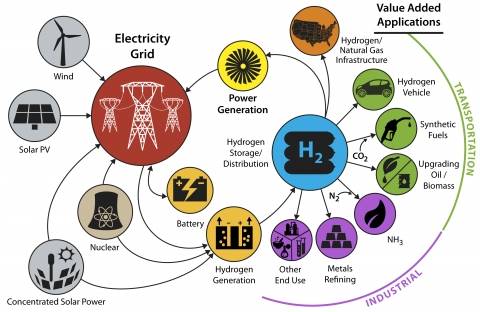Ammonia Energy Gains Recognition from U.S. Department of Energy
By Stephen H. Crolius on October 05, 2017
Ammonia Energy Anniversary Issue: a “top five” development in economic implementation
In the last 12 months …
Ammonia energy has gained recognition from the United States Department of Energy, in both bottom-up and top-down programs. This establishes ammonia energy in the world’s largest economy as a legitimate target for both public- and private-sector investment.
H2@Scale and REFUEL
A year ago, the U.S. did not seem to have any federally supported activity in ammonia energy at all. The U.S. Department of Energy’s ARPA-E program had announced its REFUEL funding opportunity in April 2016, but the scope of the program was broad, covering all liquid fuels that could be produced “from air and water using renewable energy,” including those with carbon backbones. That same month, representatives of the United States’ national laboratories unveiled the H2@Scale program, the goal of which is to explore the potential for wide-scale hydrogen production and utilization. However, ammonia was included in the program scope only as a commodity whose production generated CO2 emissions.

The situation started to change in December 2016 when ARPA-E released its list of awardees. Thirteen of the 16 successful proponents are groups focused on ammonia-related technology.
Then, in May 2017, the H2@Scale leaders gave the NH3 Fuel Association the opportunity to send a speaker to a workshop on the program’s implementation roadmap. The speaker, Steve Szymanski, Director of Business Development at NH3 Fuel Association sponsor Proton On-Site (now Nel Hydrogen), was able to convey the relevance of ammonia energy to the H2@Scale initiative, and to open the door for further contacts between H2@Scale and the ammonia energy community.
Ammonia Energy reporting
- June 2017: Ammonia energy presentation at H2@Scale Workshop
- January 2017: US DOE funding research into sustainable ammonia synthesis
- January 2017: ARPA-E’s vision for carbon neutral liquid fuels
- December 2016: Announcement of REFUEL use-side technology awards
- December 2016: Announcement of REFUEL ammonia synthesis awards
- December 2016: Grand Challenges in Sustainable Ammonia Synthesis – DOE Roundtable Report
- October 2016: ARPA-E’s “transformative” ammonia synthesis technologies
A year in review
To mark the first anniversary of Ammonia Energy, we reviewed the most important developments from the last 12 months. This “top ten” list spans two areas: five are technology advances that will arguably produce the most important opportunities for ammonia energy, and five are economic implementation steps that are arguably the most significant moves toward real-world deployment.
Technology advancement:
- The Dawn of Bio-Ammonia
- Advances in Ammonia-Fired Gas Turbines Open Up Major Use Case
- Overcoming the Selectivity Challenge in Electrochemical Ammonia Synthesis
- Progress toward Ammonia-to-Hydrogen Conversion at H2 Fueling Stations
- Development of Direct Ammonia Fuel Cells
Economic implementation:
- Yara’s Solar Ammonia Plant is a Key Step toward Global Trade in Renewable Energy
- Power-to-Ammonia: the Economic Viability of Ammonia Energy
- Green Ammonia Consortium: Bright Prospects in Japan for Ammonia as an Energy Carrier
- The Maritime Industry Begins Assessment of Ammonia as a Fuel
- Ammonia Energy Gains Recognition from U.S. Department of Energy